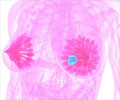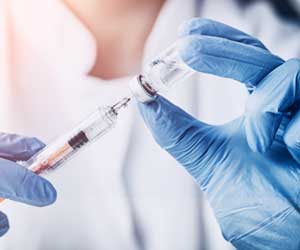- Immunotherapies known as check-point inhibitors block interaction of PD-L1 protein on the surface of tumor cells with the PD-1 protein found on T cells, and thereby making them susceptible to host immune system attack.
- Check-point inhibitors, however are not effective in all cancer types.
- Recent study identifies Eya3 protein which can be targeted to make check-point inhibitors more effective in triple negative breast cancer.
Analyzing Role Eya Family of Proteins in Cancer in Immunocompetent Mice
In order to understand how Eya proteins influenced a tumor cells interactions with a host's immune system, Ford and his team used a special kind of mouse model, termed immunocompetent mouse, in which mouse mammary tumor cells (that resemble human breast cancers), are injected into immunocompetent mice.This enabled the scientist to explore not only what happens within living cancer cells, but how these living cells interact in the presence of host tumor microenvironment that surrounds them.
Findings of Study
Ford and her team saw a completely new action of Eya3 protein.- In the immunocompetent mouse models of triple negative breast cancer, the team found that interfering with cancer cells' ability to make Eya3 protein led to a decreased formation of PD-L1 protein and higher tumor infiltration by CD8+ immune T-cells (that attack and destroy the tumor).
- Thus, if a tumor did not produce Eya3, it also did not make PD-L1, making it vulnerable to attack by the immune system.
Could Eya3 protein be the only regulator of PD-L1?
Ford says, “I don't think so. I suspect there will be other ways to regulate the protein. But in our three models, Eya3 was a key regulator of PD-L1, which argues that Eya3 is potentially a main driver of PD-L1."
- When Ford and her colleagues looked at human samples of triple negative breast cancer , they found that levels of Eya3 corresponded to the level of PD-L1 protein.
- Tumors that had high levels of Eya3 had low levels of CD8+ T cell infiltration within the tumor.
Other Links in Chain that Connect Eya3 Protein and PDL1 Protein
Other proteins have been identified which serve as a link between Eya3 and PD-L1 protein creating a rather complex network:- For instance, the PP2a gene is normally a tumor suppressor gene. However, in the presence of Eya3, the gene PP2a changed roles and became a tumor promoter.
- Another protein identified in this chain is the Myc protein that is mutated in about 70 percent cancers. Several recent studies have shown that Eya3 appeared to act via Myc protein to enhance production of PD-L1 and thus suppress the immune system.
About the Eya Protein Family
The Eya family of proteins, including Eya3, has been the focus of research in the Ford lab. The Eya proteins are critical for early embryonic development, but most of them are silent in adult tissues.The Eya protein family are complex molecules consisting of distinct regions that each have distinct functions. Until now not many had looked at the various actions of the different Eya regions within or especially outside the tumor cell microenvironment.
Previous research including the Ford Lab have shown that when cancers are able to re-stimulate the activity of Eya proteins, they function within tumor cells to drive cell growth and proliferation.
What is Triple Negative Breast Cancer?
Triple negative breast cancer does not contain estrogen or progesterone receptors or Her-2 receptors, thus being negative for all three. About 10-20 percent of breast cancers are triple negativeSuch cancers are difficult to treat as they do not respond to hormone therapy or therapy that targets Her-2. Other alternative treatments are being researched in addition to currently available standard chemotherapy.
In conclusion, this study symbolizes yet another effort aimed at making cancer treatment, in particular immunotherapy more effective in triple negative breast cancer and hoping to improve the outcome for the patient.
References:
- Triple negative breast cancer - (http://www.cancerresearchuk.org/about-cancer/breast-cancer/stages-types-grades/types/triple-negative-breast-cancer)
- Who gets Triple Negative Breast Cancer - (http://www.breastcancer.org/symptoms/diagnosis/trip_neg)
Source-Medindia
















